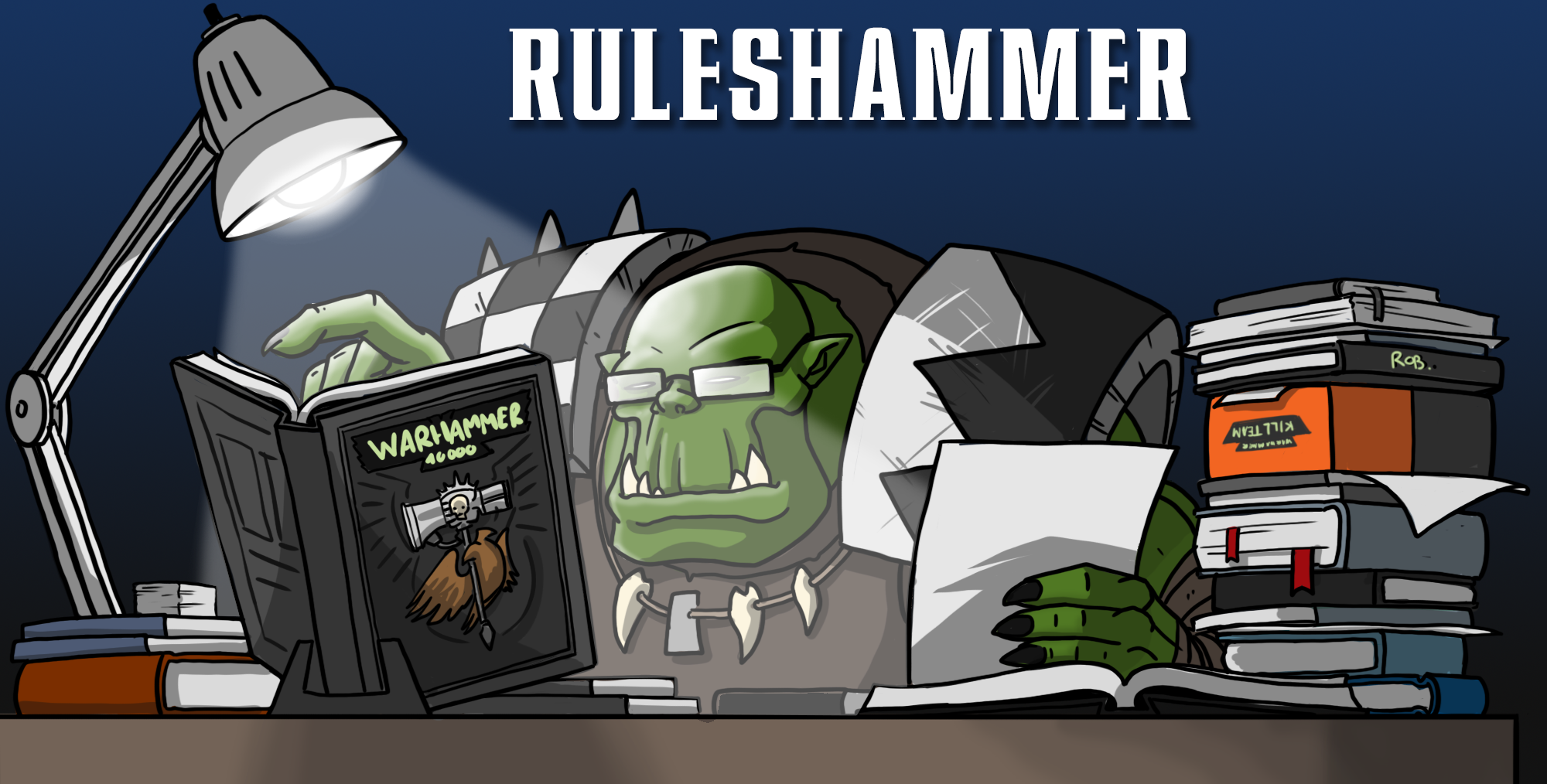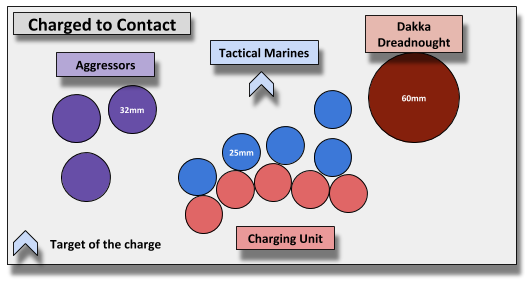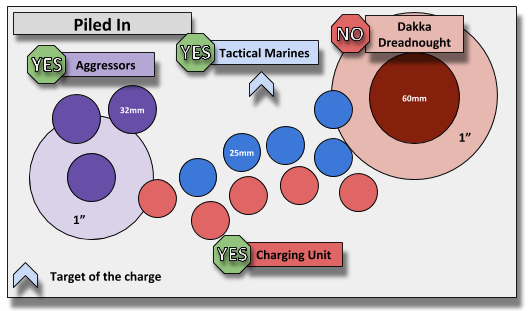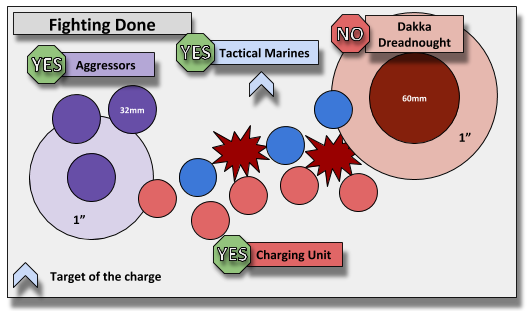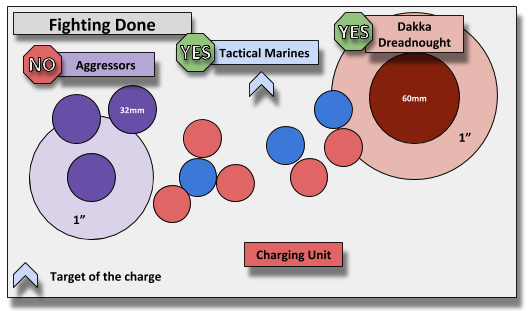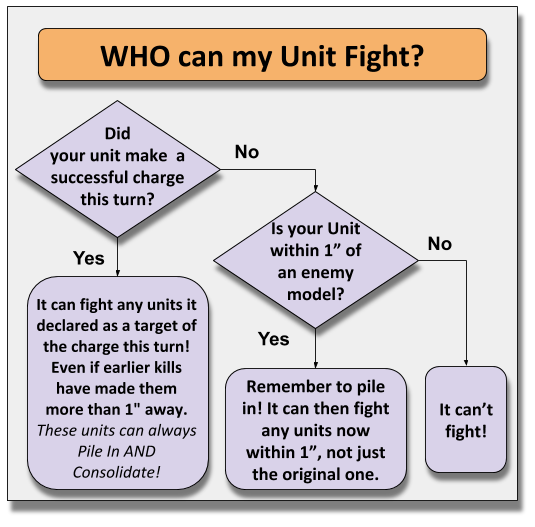Although we love Warhammer 40,000, the game’s complexity can be daunting, particularly for newer players. In Ruleshammer, we look at the nuances of the game’s rules and how they affect gameplay, clearing up potential issues and helping make sense of some of the game’s less common interactions. In today’s Ruleshammer, Rob “Vre’kais” Chilton is looking at who can fight in the Fight phase.
By popular demand this article will cover some of the more confusing aspects of the Fight Phase, the sad middle child of a phase that so often gets treated as if it’s part of the Charge phase.
What are the rules for who can fight then?
Any unit that charged or has models within 1″ of an enemy unit can be chosen to fight in the Fight phase. [Core Rules 40k, Pg. 8]
So from that we can make a quick flow chart for which units can be selected to fight:
So now you know which units can fight, for exactly how many models will get to fight I humbly recommend my How May Models Can Fight in the Fight Phase? article from last week.
So I’ve selected one of my units that charged this turn, now what?
Well, we covered the basic sequence last time, but let’s review:
-
Select a unit to fight with. This unit needs to have at least 1 model within 1″ of the enemy to be selected, or it has to have charged this turn.
- Make your Pile In moves.
-
Determine which are the eligible models that are in combat range.
-
If those models are able to attack more than one enemy unit, declare the targets and weapons being used against each of the enemy units.
-
Make attacks as usual.
- Make your Consolidate moves.
Piling In
When piling in, most models can move 3” (some can move further like Hormagaunts who have an ability that allows them to move 6” when piling in). There are some conditions to this move though so first lets get the rule to look at:
You may move each model in the unit up to 3″ – this move can be in any direction so long as the model ends the move closer to the nearest enemy model. [Core Rules 40k, Pg. 8]
The important thing to note here is that the pile in move has to move you closer to the closest enemy model, so where you end your charge can determine your options at this stage:
In the diagram above, the unit has charged right into base-to-base contact with all of their models. Remember though that to pile in you need to end the move closer to the nearest enemy model. If a model is in base contact with an enemy model, it can’t pile in, it’s impossible in the 3D reality we play games in to move closer to something than touching it (one of the advantages of Table Top Games is the “no-clip” is usually not a thing, except for Ruins and Infantry though).
Note that if a model is in base-to-base contact, it cannot possibly end a move closer to the enemy, and so cannot move when its unit piles in or consolidates. [Core Rules 40k, Pg. 5]
For now let’s say the charging unit did something slightly different, to explore how Pile-in and Consolidate work, and can be used.
This time the unit has charged to within 1” as required but not to base to base contact. This means they have some options when piling in. Let’s see what they can achieve with their 3” in this scenario.
So they’ve moved their 3” and have moved around to tag a few more targets in combat. Remember though that there are pros and cons to this; the charging unit only declared the unit of Tactical Marines in the centre unit as a target; so that is the only target that it can fight this turn, even if it ends up within 1″ of the Aggressors after piling in. Once they’ve finished fighting, the opposing player can activate every unit that has models within 1″ of the charging unit to fight with. As those units haven’t charged this turn they could attack anything they’re in range of after they pile in.
That might sound like the charging player has made some mistake but often this is beneficial; if the charging unit piles in to combat with the Dreadnought, it will now have to choose whether to stay in combat or Fall Back during its Movement phase. Assuming these aren’t Ultramarines units and barring any special stratagems, either choice will prevent the dreadnought from shooting that turn.
Fighting Time
Fighting in combat works much like the shooting phase, and we’ve already covered combat range, so here let’s sum up what’s happened so far and which units can fight what in our scenario with a clear diagram. Remember that selecting a unit to fight with means it gets to pile in as well.
Here’s the units that could currently fight this turn fight, it could change depending on losses and consolidation though. I’ve included some range circles around a few models to help illustrate the distances. Let’s see what damage the charging unit manages to inflict.
The charging unit attacked and has managed to kill a few models. Arguably the models removed by the space marine player in this example are tactical errors on their part; we need to see the consolidation for it to become apparent why.
Consolidation at Last!
So the charging unit has fought, some models have died, it can now consolidate. This is a major difference from previous editions where Consolidation was the rule for moving after entirely wiping out a unit. Let’s look at the rules again.
You may move each model in the unit up to 3″ – this move can be in any direction so long as the model ends the move closer to the nearest enemy model. [Core Rules 40k, Pg. 9]
Once again the moving models must end their moves closer to the nearest enemy model (note that this does not mean they have to move directly toward those models). Depending how you placed your models and what has died, this can be a significant move. So finally; the diagram below shows the final positioning for each of these models:
1. The unit of Aggressors that could be selected to fight a moment ago is now too far away to do so. This has been covered by an FAQ;
Q: If a unit starts the Fight phase within 1″ of an enemy unit but, due to casualties suffered and models removed, it is no longer within 1″ of any enemy units later in the phase, can it still be chosen to fight?
A: No, unless the unit in question charged this turn it cannot be chosen to fight if there are no longer enemy units within 1″. Note that it is possible – if heavy enough casualties have been incurred – that even a unit that did charge may not be close enough, even after a pile in move, to make close combat attacks. It can still, of course, consolidate. [Core Rules FAQ, pg. 5]
So because that unit hasn’t charged this turn, they can’t fight anymore now that consolidation has moved the unit out of range. Important Note: This FAQ also clarifies that removing models from a unit when attacked does not prevent another unit that charged this turn from piling in and attacking later, so long as the 3″ pile-in towards the nearest enemy model is enough to get them back within 1″. If they can’t get to with 1″ they can’t fight, but they can still consolidate.
2. The Marine unit is currently locked in combat.
Unless the Marines and the Dakka Dreadnought (which is a dreadnought without dedicated close combat weapons by the way) manage to kill 3 models, the leftmost Marine is surrounded on three sides and would not be able to fall back, since doing so would require that it move through another model (and it lacks the FLY keyword).
3. The Dakka Dreadnought can now fight and might also suffer some Combat consequences.
While the Dreadnought is not locked in combat like the Marines, if the model within 1″ of it is not killed by either its attacks or the Tactical Squad’s attacks, then in the following turn it will need to choose between making a Fall Back move (and not shooting) or staying in combat to fight again (also, not shooting). Note: If the Marines and Dreadnought totally fail to kill any models with their attacks in the Fight phase then not only would the marines be locked in combat but nothing would be able to shoot at the unit that charged in the following turn (except the Marines, if they have Pistols).
That concludes this unit’s pile-in, fight and consolidation. You’d now move on to the next unit that charged this turn, and after all of those have fought you alternate between current and opposing player to resolve all the units that didn’t charge this turn but that are within 1” of enemy models.
We’ve covered the basics here, but if you want to get into more detail on the nuances of positioning, using this to your advantage in competitive games, and avoiding common pitfalls, check out our Start Competing article on The Charge and Fight Phases.
What about the units that can fight but didn’t charge?
Any unit eligible to fight can make a Pile-in move, fight and consolidate.
Non-charged units:
-
Can only be activated in the Fight phase if there are currently enemy models within 1″ of a model in their unit, BEFORE they pile-in.
-
Can attack any unit they are within 1″ of after their Pile-in move.
Charging units:
-
Can only target units they declared as targets of their charge with their attacks in the Fight phase.
-
Can still be activated to Pile in, Fight, and Consolidate even if the enemy has removed models to make them more than 1″ away from an enemy unit.
What about stratagems or abilities that allow a unit to fight again?
In short these stratagems let you repeat the Pile-In, Fight and Consolidate process for that unit.
Q: If a rule states that you can choose a unit to ‘fight again’, what does this mean exactly?
A: Repeat the entire Fight phase for that unit – i.e. choose to fight with the unit, pile in with that unit, choose its target, choose its melee weapon, resolve its close combat attacks, then consolidate with it. [Core Rules FAQ, pg. 13]
They do not however override the limits on what they can target. If they charged they can still only attack the units that they charged this turn;
Q: If a unit that can fight twice in the Fight phase charges one enemy unit and destroys it during their first ‘fight’ in the subsequent Fight phase, and then consolidates into a second enemy unit, can they then attack that unit during their second ‘fight’?
A: The charging unit can only make attacks against the second unit if it also declared a charge against it in its charge phase. [Core Rules FAQ pg13]
If in doubt use this “Who can my unit fight?” flow chart:
Does declaring a charge but failing count as charging?
Since posting this, one thing has been brought to my attention that was definitely worth adding: There is a difference in the rules between declaring a charge and succeeding at a charge.
Q: When a unit is chosen to make a charge move and fails the charge, do they still count as having charged? Specifically, can a unit that has failed a charge move be chosen to pile in – and potentially consolidate – towards the enemy?
A: A unit only counts as having charged if they made a charge move. If a charge fails, and no models make a charge move, they do not count as having charged. As such, they cannot be chosen to fight in the Fight phase (and so cannot pile in or consolidate) unless an enemy unit moves within 1″ of them. [Core Rules FAQ, Pg. 10]
Units that fail their charge roll do not count as having charged. So if somehow the enemy managed to Pile-in to within 1″ of such a unit (perhaps Hormagaunts with their 6″ pile in move), it would follow the flow chart as normal for a unit that hasn’t charged this turn, and be able to attack as normal. Note that you only have to successfully charge one unit to count as having charged, so if you declare charges against five units but only roll high enough to reach one, you can still fight those other four units in the Fight phase if you’re able to reach them through Pile In or Consolidate moves.
I hope this has helped to clear up the Pile In and Consolidation rules, maybe it’s just made you think of even more questions. I’m always after more rules issues for future posts or Q&As, you can submit them here, or you can join the discussions on Reddit here. Or drop us a note in the comments below or email us at contact@goonhammer.com.
